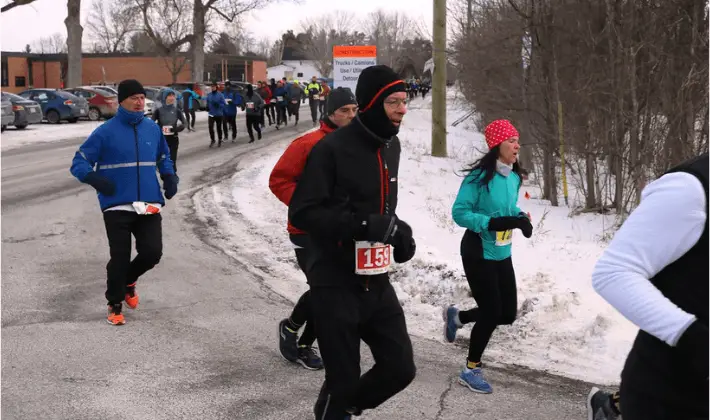Tips, Benefits & Risks Of Running In Cold Weather

Running in cold and frigid weather during the winter season sounds horrible to most people. Dependant on where you live, it can vary from running in low temperatures to running in extreme cold with frigid winds and slippery ice /foot-numbing snow underfoot
But running in cold weather does not have to be a wretched affair if you approach it in the correct way—like wearing the right gear, warming up properly and being mentally and physically prepared.
I have written this article to provide details about various aspects of running in cold weather or winters. You will find information about the benefits & risks of low temperature running, what you should wear, and tips for making your run easier and comfortable.
Benefits of Running in Cold Weather
And running in cold weather actually provides some benefits:
- Helps beat the winter blues
- Increases your aerobic activity in winter/ cold weather
- Revs up the metabolism
- Burns more calories
- Helps get faster times
- Provides an opportunity to get Vitamin D exposure
- Good for immune system (winters enhances body’s resistance)
- Reduces stress
Risks of Low Temperature Running
But while running outside in very cold temperatures can be stimulating, it can also be risky for some people.
- Be careful if you have a history of cardiovascular disease. Exercising in cold can cause strain, increase BP and become potentially dangerous for people with heart diseases.
- The cold, dry air might stress your lungs in case of prolonged exercise in extreme cold.
- Overdoing running in extreme cold weather also ups the risk of upper respiratory tract and bronchial infections.
- Increase in vulnerability to hypothermia if you are inappropriately dressed and are outside for a long duration in extremely cold weather
- Muscles strain or muscle cramps is a possibility if the warm-up phase is too short.
What to Wear for Running in Cold Weather (Winter Running Gear)?
Now let us get down to brass tacks and move to basic things to keep in mind pre-run, during the run and post-run
1. Think like an onion. Be an onion. Layer up!
There is an old expression about weather – “There is no such thing as bad weather, only bad clothing.” Appropriate clothing not only helps regulate the body temperature but also reduces the risk of cold-related illnesses. So while preparing to run in cold weather, dress in layers where each layer fulfils a functional need.
- Base layer: Functions to keep you dry & warm
The first layer should be snug fitting and moisture wicking which keeps you dry. The aim is that the sweat should not evaporate against your skin (hence cooling you down). Instead the clothing should hold the heat close to your body while wicking the sweat away from your body. So wool or a technical fabric long sleeve t-shirt should work
- Middle Layer: Functions as Insulating layer
The second layer is for heat regulation. A warming garment such as a wool or merino or fleece or a special winter running jacket is the best choice. The thickness can vary depending on the temperature
- Outer Layer: Functions as protection against wind and rain
The third layer should protect you against wind and water so wear a jacket which is wind-resistant and water-resistant. Look for pockets as they help stash keys, ID, cash and even gloves. Also try and wear a jacket with a zipper so that you can easily regulate your temperature by zipping it up and down.
2. Cover all exposed skin as well as body extremities
Since the heart is working hard to direct blood to larger muscles for the running momentum, it takes more effort to keep blood flowing in the extremities to keep them warm. Hence, try and minimize skin exposure.
To minimize heat loss, keep all extremities covered including ears, head, neck, hands, wrists, ankles and feet.
- Mittens are warmer than gloves and a better choice if it is extremely cold. If it is really cold and you want your fingers to keep working, you can wear a pair of sweat wicking thin gloves and then add a heavier pair of mittens/ gloves on top.
- A fleece or wool hat will keep the head warm during cold winter runs. But if you feel a woolen hat is uncomfortable as it might overheat, using a headband might be a better option. A head band keeps the ears warm but at the same time, does not trap too much heat
- Wearing a neck warmer or neck gaiters or even a buff can help prevent heat loss from the neck. In case you feel uncomfortable breathing in the cold air, you can also pull up the neck gaiter and breathe through it
- Wear sunglasses if you are running in the snow. Sun’s rays reflect off the snow and can cause you to squint
3. Skin and lip protection
Wind and cold weather can chap the lips and make any exposed skin crack. Runners can protect themselves by using vaseline or any other lubricant which will not only help prevent chapped lips but also prevent windburn on nose and cheeks. Wearing a layer of sunscreen is also advised if you are running in a snowy region.
4. Wear the Right Shoes
Try and run in shoes that keep warmth in and wetness/ slush out. So look for shoes with the least amount of mesh and/or have water resistant uppers.
And try and avoid puddles, slush or snow. If avoiding snow is not an option, buy trail running shoes which provide more traction or alternatively wear removable traction devices/patterns on your shoes to combat slippery surfaces. That obviously means that you should regularly change shoes before the tread wears out completely due to overuse
Some shoe related hacks to get by
- Wear a plastic cover on your feet before you slip on your shoes (will help feet stay dry even if you step into a puddle)
- If your shoes have breathable uppers (good for summers but not so much in rains, snow or cold), cover them with duct tape to help get over the elements temporarily.
- To help dry shoes overnight, stuff crumpled up newspapers tightly into the shoes after removing the insoles. Replace the stuffing after a couple of hours, if needed. Do not try and dry out the shoes in front of heaters/ blow dryers / radiators – direct heat will make the shoes stiff
5. Take care of socks too!
Wear socks that wick away wetness but keep your feet warm. Irrespective of weather, never wear cotton socks while running because they do not wick away the sweat/moisture, leaving your feet wet and hence prone to blisters.
Also keep in mind that if you wear thicker socks in winter, you might need to buy slightly larger sized shoes to accommodate the thicker socks
6. Underdress!
Always remember that you will start sweating after you have run a certain distance/ time. So follow a simple rule of thumb → dress as if it is 10-20 degrees warmer so that you stay warm but without copious amounts of sweating (leading to post-run chills). So feeling slightly cool at the start of your run is what you should aim for.
If it is windy, check the ‘feels like’ temperature to decide what to wear (using the same 10-20 degree warmer rule)
A rough temperature guide:
If below 15℃ / 60℉ : Running vest /short sleeve technical shirt and shorts
If below 10℃ / 50℉ : Long sleeve technical shirt, shorts or tights/leggings, gloves (optional) and headband (optional)
If below 4℃ / 40℉: Long sleeve technical shirt, running tights/leggings, wind & water resistant jacket, gloves and headband
If below -1℃ / 30℉: Two shirts layered—a long sleeve tech shirt and a short sleeve tech shirt, running tights/leggings, wind & water resistant jacket, gloves and headband /hat and warm socks.
If below -6℃ / 20℉: Start with a long-sleeve running shirt and running tights/tights and then layer up with a fleece upper layer as well as an extra pair of running pants (or running skirt/ shorts). Wear an outer lightweight jacket and add a hat, thick gloves (or maybe wear two pairs), warm socks and a neck gaiter as well.
It is difficult to provide a one-clothing guide-fits-all for cold weather running, so you need to experiment and see what works for you.
7. Get Lit
Winters usually mean limited daylight and hence running in dark (which is a safety threat). Wear reflective and fluorescent clothing & running gear. Use a headlamp – not only to see the path ahead but also be seen by vehicle drivers.
Tip for Running in Cold Weather (Winters)
1. Warm Up Pre-run
Try and warm up indoors if possible. Move around inside to get the blood flowing and to help activate your legs and core without breaking into a sweat. Run up and down your stairs, march in place, do jumping jacks, use a jump rope, do a few lunges (forward, reverse) or do a few yoga sun salutations. If you are doing your warm up outside, wear an extra layer which can be easily removed post the warm up.
Ideally the warm up phase in cold weather should be longer than that in summers
2. Plan the route
Plan your route in advance depending on how long/far you want to run. If running alone, plan for running in smaller loops instead one single long one. This will provide you not only with an exit plan (in case you want to cut short your run) but also a safe place to keep your extra layers and hydration etc. Earmark a safe, warm/dry place on your route which can provide shelter in case of emergency/ inclement weather. Also let someone know when and where you are planning to run (a possible route map) with an approximate finish time.
3. Take it slower
Not only should you start the run at a comfortable pace and slowly build up your pace, but you should also try and stay within the aerobic zone. While running in the cold will give you faster times, you need to remember that the heart beats faster when it’s cold, intensifying any outdoor run. So unless you are racing an event, keep it slow and steady
Also any changes in direction should be gradual to avoid slipping or pulling muscles.
4. Be Flexible With Pace and Mileage
Running in winters is more about maintenance than speedwork. So if running your planned mileage in one go means staying out for too long in extreme cold, split the distance and run twice a day. Also be moderate about your total mileage in extreme cold weather
5. Leave the headphones at home
Considering the not-so-favourable conditions of less light/ darkness, less visibility (yours as well as of vehicle drivers), icy/snow covered roads, etc, it is better to leave the music at home so that you can hear your surroundings better
6. Run with a buddy or a group!
Running with someone makes you accountable and provides the motivation to be there at the starting point. It is also a good strategy as there is safety in numbers in case of any emergency
7. Look out for each other
Be aware and keep checking on each other to prevent possible hypothermia* or frostbite** especially if you or your running mates have any exposed skin. Get to a warm and dry place and seek immediate medical aid if you suspect either
*Hypothermia indicates a drop in the body’s core temperature and symptoms include persistent shivering, incoherent or slurred speech, clumsy fingers and poor coordination.
**Frostbite usually leaves the affected area white with blotchy patches, numb/ dead to any sensation and unresponsive /non bouncy on pressing.
8. Hydrate
When it is cold outside, we might not sweat as much and hence not notice our thirst as acutely as we do in summers. However, we are still losing lots of liquid and need to replenish it!
If you run with hydration, start with warm water so that it is not slushy/icy cold when you actually drink it. Alternatively, choose a looped course such that you can keep & access hydration from your car – away from direct cold. Drinking ice-cold water when it is already cold outside can further decrease the body’s core temperature.
9. Be prepared for emergency
Try and carry your mobile phone, some cash and ID for any untoward situation .
10. Be prepared for the winds:
Try and run opposite to the wind for the first part of your run and then in the same direction as the wind on your return. Also, keep in mind, wind chill measures rate of cooling and not actual temperature so be prepared for windy conditions on days of ‘high wind chill’.
Post Run Checklist
1. Have a extra pair of clothes handy
The core body temperature drops quickly once you stop running – leading to chills especially in winters. Change your clothes / under garments, get out of wet shoes, and have towels handy to dry out wet hair. If possible, drink something warm/ hot as soon as possible. And better still, get into a warm shower
2. Do not forget your cool down
After you complete your run, get somewhere warm as soon as possible. Take a bath or change into dry clothes and then do your cool down stretches
And always remember → If it is too cold outside or if the local weather authority has issued adverse outdoor weather warnings, try and find an alternative to running outside. You can run on a treadmill or use the day for cross-training or strength training.





